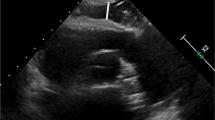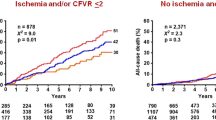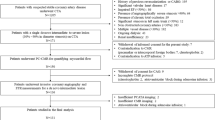Abstract
BACKGROUND: Chronic myocardial ischaemia due to coronary artery stenosis or occlusion has been shown to increase the growth of coronary collateral circulation. Collateralization leads to increased oxygen delivery to the area at risk and hence may reduce ischaemia, prevent infarction and preserve contractile function. However, there is considerable variation among patient subsets in terms of the presence or degree of collateralization. We aimed to evaluate the relationship between obesity and co-ronary collateral development in patients with ischaemic heart disease.
METHODS AND RESULTS: In all, 215 patients (mean age, 57.8±8.9 y) with body mass index (BMI)≥30 kg/m2 were enrolled into our study. A total of 90 age- and sex-matched patients (mean age, 58.7±10 y) with BMI<25 kg/m2 and significant coronary artery disease were selected as a control group. The mean age and distribution of risk factors for coronary heart disease were not significantly different between two groups other than poorer HDL cholesterol and triglyceride profile in obese patients. The mean BMI was significantly higher in the patient group (33.3±2.4 vs 22.8±1.7, P<0.001). The mean number of diseased vessels and maximum lesion severity were not significantly different between the two groups. The mean Rentrop collateral score of the patient group was significantly worse than the control group (1.08±0.68 vs 2.10±0.72, P<0.001).
CONCLUSIONS: Our findings suggest that collateral vessel development is poorer in obese patients (defined as BMI≥30 kg/m2) with ischemic heart disease compared to normal range BMI, and the risk of having poor collateral vessel development is significantly increased. However, this might be reflecting the cluster of risk factors, associated with metabolic syndrome, in which insulin resistance plays a major role.
This is a preview of subscription content, access via your institution
Access options
Subscribe to this journal
Receive 12 print issues and online access
$259.00 per year
only $21.58 per issue
Buy this article
- Purchase on Springer Link
- Instant access to full article PDF
Prices may be subject to local taxes which are calculated during checkout
Similar content being viewed by others
References
Meininger CJ, Schelling ME, Granger HJ . Adenosine and hypoxia stimulate proliferation and migration of endothelial cells. Am J Physiol 1988; 255: H554–H562.
Schaper W . Angiogenesis in the adult heart. Basic Res Cardiol 1991; 86 (Suppl 2): 51–56.
Chilian WM, Mass HJ, Williams SE, Layne SM, Smith EE, Scheel KW . Microvascular occlusions promote coronary collateral growth. Am J Physiol 1990; 258: H1103–H1111.
Levy AP, Levy NS, Wegner S, Goldberg MA . Transcriptional regulation of the rat vascular endothelial growth factor gene by hypoxia. J Biol Chem 1995; 270: 13333–13340.
Abaci A, Oguzhan A, Kahraman S, Eryol NK, Unal S, Arinc H, Ergin A . Effect of diabetes mellitus on formation of coronary collateral vessels. Circulation 1999; 99 (17): 2239–2242.
Waltenberger J . Impaired collateral vessel development in diabetes: potential cellular mechanisms and therapeutic implications. Cardiovasc Res 2001; 49: 554–560.
Abbott RD, Donahue RP, Kannel WB, Wilson PF . The impact of diabetes on survival following myocardial infarction in men vs women: the Framingham study. JAMA 1988; 260: 3456–3460.
Jonsson S, Hedblad B, Engstrom G, Nilsson P, Berglund G, Janzon L . Influence of obesity on cardiovascular risk. Twenty-three-year follow-up of 22,025 men from an urban Swedish population. Int J Obes Relat Metab Disord 2002; 26 (8): 1046–1053.
Cohen M, Rentrop KP . Limitation of myocardial ischemia by collateral circulation during sudden controlled coronary artery occlusion in human subjects: a prospective study. Circulation 1986; 75: 325–334.
Must A, Spadano J, Coakley EH, Field AE, Colditz G, Dietz WH . The disease burden associated with overweight and obesity. JAMA 1999; 282: 1523–1529.
NHLBI Obesity Education Initiative. Summary report: strategy development workshop for public education on weight and obesity. NIH Publication 94-3314 National Institutes of Health: Bethesda, MD; 1994. p. 139.
Messerli FH, Sundgaard-Riise K, Reisin ED et al. Dimorphic cardiac adaptation to obesity and arterial hypertension. Ann Intern Med 1983; 99: 757–761.
Kasper EK, Hruban RH, Baughman KL . Cardiomyopathy of obesity; a clinicopathologic evaluation of 43 obese patients with heart failure. Am J Cardiol 1992; 70: 921–924.
Rosengren A, Wedel H, Wilhelmsen L . Body weight and weight gain during adult life in men in relation to coronary heart disease and mortality. A prospective population study. Eur Heart J 1999; 20: 269–277.
Manson JE, Colditz GA, Stampfer MJ et al. A prospective study of obesity and risk of coronary heart disease in women. N Engl J Med 1990; 322: 882–889.
Helfant RH, Vokonas PS, Gorlin R . Functional importance of the human coronary collateral circulation. New Engl J Med 1971; 284: 1277–1281.
Habib GB, Heibig J, Forman SA et al. Influence of coronary collateral vessels on myocardial infarct size in humans, results of phase I thrombolysis in myocardial infarction (TIMI) trial. Circulation 1991; 83: 739–746.
Hansen JF . Coronary collateral circulation, clinical significance and influence on survival in patients with coronary artery disease. Am Heart J 1989; 117: 290–295.
Shweiki D, Itin A, Soffer D et al. Vascular endothelial growth factor induced by hypoxia may mediate hypoxia-initiated angiogenesis. Nature 1992; 359: 843–845.
Lee SH, Wolf PL, Escudero R et al. Early expression of angiogenesis factors in acute myocardial ischemia and infarction. N Engl J Med 2000; 342: 626–633.
Chou E, Suzuma I, Way KJ et al. Decreased expression of vascular endothelial growth factor and its receptors in insulin resistant and diabetic states. Circulation 2002; 105: 373–379.
Onat A, Büyükbese MA, Ural D, Keles I, Ural E, Sansoy V . Sigara icimi, obesite, fizik aktivite ve diyabet: Marmara bolgesi halkinda nereye yoneliyor? Arch Turk Soc Cardiol 1998; 26: 72–78.
Schaper W, Gorge G, Winkler B, Schaper J . The collateral circulation of the heart. Prog Cardiovasc Dis 1988; 31: 57–77.
Ferguson RJ, Petitclerc R, Choquette G et al. Effect of physical training on treadmill exercise capacity, collateral circulation and progression of coronary disease. Am J Cardiol 1974; 34: 764–769.
Blair SN . Evidence for success of exercise in weight loss and control. Ann Intern Med 1993; 119: 702–706.
Andersen RE, Wadden TA, Bartlett SJ et al. Effects of life-style activity versus structured aerobic exercise in obese women. A randomized trial. JAMA 1999; 281: 335–340.
Wackers FJTh . Myocardial perfusion imaging. In: Sandler MP, Coleman RE, Wackers FJTh et al (eds) Diagnostic nuclear medicine, 3rd edn. Williams & Wilkins: Baltimore; 1995. p. 443.
Charney R, Cohen M . The role of the coronary collateral circulation in limiting myocardial ischemia and infarct size. Am Heart J 1993; 126: 937–945.
Pijls NH, Bech GJ, el Gamal MI et al. Quantification of recruitable coronary collateral blood flow in conscious humans and its potential to predict future ischemic events. J Am Coll Cardiol 1995; 25: 1522–1528.
Fletcher GF, Blair SN, Blumenthal J et al. Statement on exercise: benefits and recommendations for physical activity programs for all Americans: a statement for health professionals by the Committee on Exercise and Cardiac Rehabilitation of the Council on Clinical Cardiology, American Heart Association. Circulation 1992; 86: 340–344.
Hubert HB, Feinleib M, McNamara P, Castelli WP . Obesity as an independent risk factor for cardiovascular disease: a 26-year follow-up in the Framingham Heart Study. 1983; 67: 968–977.
Author information
Authors and Affiliations
Corresponding author
Rights and permissions
About this article
Cite this article
Yilmaz, M., Biyikoglu, S., Akin, Y. et al. Obesity is associated with impaired coronary collateral vessel development. Int J Obes 27, 1541–1545 (2003). https://doi.org/10.1038/sj.ijo.0802474
Received:
Revised:
Accepted:
Published:
Issue Date:
DOI: https://doi.org/10.1038/sj.ijo.0802474
Keywords
This article is cited by
-
Nifedipine ameliorates ischemia-induced revascularization in diet-induced obese mice
American Journal of Hypertension (2012)
-
Endothelial Progenitor Cell Function, Apoptosis, and Telomere Length in Overweight/Obese Humans
Obesity (2010)
-
Endothelial progenitor cell number and colony-forming capacity in overweight and obese adults
International Journal of Obesity (2009)
-
Insulin activates hypoxia-inducible factor-1α in human and rat vascular smooth muscle cells via phosphatidylinositol-3 kinase and mitogen-activated protein kinase pathways: impairment in insulin resistance owing to defects in insulin signalling
Diabetologia (2006)
-
High blood pressure is inversely related with the presence and extent of coronary collaterals
Journal of Human Hypertension (2005)



